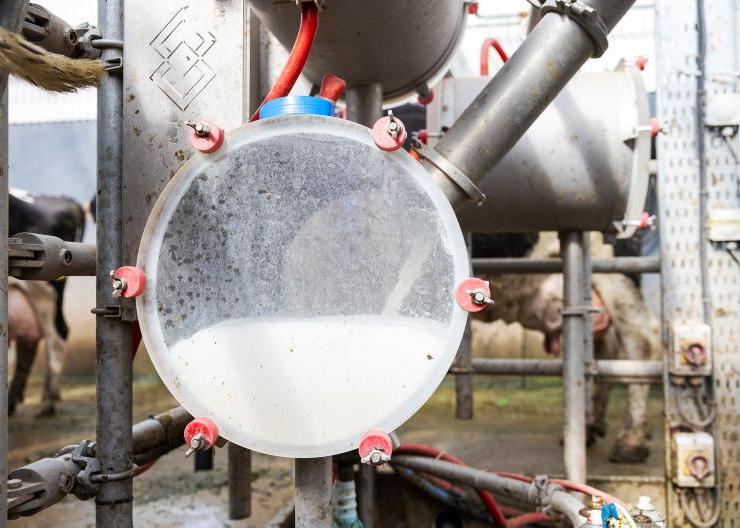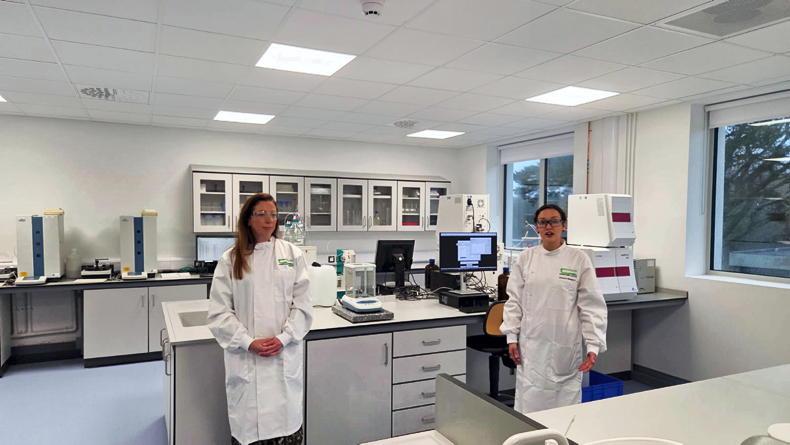When it comes to living well before and after menopause, we should take some inspiration from Japanese women. They don’t have a phrase for “hot flush” apparently. That’s because they eat a lot of plant-based foods and don’t experience this common menopausal symptom as often as women in other parts of the world do.
“It’s because their diet will contain up to 100mg of important compounds called phytoestrogens [plant oestrogens] a day whereas the Irish diet might contain only 3mg,” says dietitian Aveen Bannon, who recently spoke at the National Menopause Summit in Dublin.
Phytoestrogens are plant-based oestrogens that, when part of a daily diet, can lessen menopausal symptoms. That’s because they imitate the effect of oestrogen on a woman’s body and help to rebalance her hormones at a time when her oestrogen levels are decreasing.
Foods that are high in phytoestrogens include flaxseed, linseed, chickpeas, lentils, soya, tofu (soybean curd) and tempeh (a protein source and cake-like substance made from cooked and fermented soybeans).

Davina McCall, who spoke at the recent National Menopause Summit, pictured with Gráinne Seoige
“We know that when phytoestrogens are part of your diet, they may help reduce hot flushes but it’s not a case of taking high doses. [Meals that include some of] these foods should be spread throughout the day for maximum benefit.”
Tips for incorporating phytoestrogens
She suggests making a habit of incorporating them in your daily diet rather than thinking that you have to learn new recipes or a new way of cooking.
“You could have flaxseed on your breakfast, hummus as a snack or on a sandwich and add lentils or chickpeas to a soup, for example. If I’m making a shepherd’s pie or Bolognese now, I add a tin of lentils to it or if I’m making a chicken curry I throw a tin of chickpeas in. I would add kidney beans to a chilli too. If I’m doing a tuna salad at lunchtime I might mix beans with it too. You can use the fresh ones or the dried ones that you can soak overnight, but for convenience I just buy the tinned ones each week. That makes it very much part of my day-to-day diet.”
When discussing diet and menopause, Aveen takes a two-pronged approach.
“The first is managing the symptoms and the second is future proofing your health, paying attention to your bone and heart health.”
Managing symptoms
There are over 40 symptoms that can be experienced during perimenopause, but the best known are hot flushes, bowel issues and disrupted sleep patterns.
Weight gain can occur too, but hitting menopause needn’t necessarily mean that you gain weight, she says.
“You shouldn’t feel that it is inevitable,” she adds. “What you need to do is make sure that you are getting the right balance of protein and fibre in your diet. That means making your porridge with milk rather than water so that you’re getting protein into it. Have protein in your sandwich at lunch and again in your evening meal.
“Balancing your protein and fibre intake and keeping active helps with weight management.”
All this is very important at what can be a particularly stressful period in a woman’s life.
“At this time there can be more stress, joint pain, work pressures and digestive issues for women, so many things that can put you off exercise or throw you off your diet. It’s about keeping it simple, having basic meals but making sure that there is always protein and fibre in them.”
She points out that the higher your fibre intake, the lower your sugar intake.
“Rather than looking at labels for what we shouldn’t eat, we should be looking at labels and saying, ‘Well, I should be eating that’, so pick the cereal with more fibre or the sandwich that has more protein in it. That way you’ll be choosing wisely for what your body needs.”
Bone health
Taking care of your bone health is extremely important at this time too.
“Calcium intake is crucial as you can lose up to 20% of your bone mass during the menopause phase,” she says. “Bone is a live tissue so we need calcium every single day.”
Calcium-rich foods include milk, yoghurt, cheese, some green vegetables like broccoli, some nuts and tinned fish.
She is concerned that many women change their dairy eating patterns around this time, which is something that can affect them negatively.
“What we find is that women start to reduce their dairy intake, saying, ‘I won’t have a latte, I’ll have an Americano instead’, or ‘I’m not eating cheese’. They pull back because of a perception that this will help with weight or cholesterol control but then their bodies are not getting enough calcium for their bones at a time when they really need it.”
She also has some advice around soya and other alternatives to milk.
“If you are going for a soya [alternative], go for one that has calcium added to it and make sure you shake it well before you use it,” she says.
“Oat, soya and almond alternatives are available now but from a nutritional point of view, cow’s milk is deemed to be the most nutritious, ticking all the boxes. That’s because it has the right combinations of nutrients for bone health. It has your calcium, phosphorous, magnesium, B12 and it also contains iodine which is important for thyroid function. Soya is next best but it doesn’t have iodine.”

Dietitian Aveen Bannon recently spoke at the National Menopause Summit in Dublin.
Juices like almond or oat have very little protein in them, she says.
“We don’t have as good a calcium intake from those plant alternatives. There is a thing called the dairy matrix and we know that calcium is better absorbed when it is taken with the protein.”
It’s also important to note how essential vitamin D is. You can be consuming the correct amount of calcium but without vitamin D your body can’t absorb it. Most people are deficient in this vitamin (your GP can check your level with a simple blood test) so make sure you are taking a daily supplement, particularly during the winter months.
Tea and toast isn’t enough
Tea and toast doesn’t cut it as a proper breakfast, she adds.
“If someone has just tea and toast for breakfast, they are not getting any protein. We would say have an egg with it or put some peanut butter and maybe a banana on it or include a yoghurt. People often think of protein as meat or fish but it doesn’t have to be that type of protein. It could be a dairy source or an egg.”
Heart health
If you’re doing all the above, you will be looking after your heart health as well, she says.
“Omega 3s might be one to potentially include too, like your oily fish. Plant sources of Omega 3 would be walnuts or flaxseed or linseed or walnut oil or rapeseed oil. That’s heart healthy fat that’s also good for your joints. A lot of women experience joint pain throughout menopause so Omega 3 is important.”
Aveen Bannon believes that if your diet and sleep patterns are good, then you have an advantage on the feeling-well front.
“You just tend to feel in a better place. When your diet is bad and you’re not getting proper sleep, you just don’t feel as well.”
Not getting enough sleep can also lead to eating more during the day and perhaps gaining weight.
“Sleep seems to be a problem for many women going through menopause, so if you get less than five and a half hours sleep per night, there’s research that shows that you are more likely to eat an extra 200 calories per day so that’s where the weight/sleep conundrum comes into play.”
Read more
“See a gynaecologist and have everything checked: it’s what saved me”
Postnatal depression: a real illness
When it comes to living well before and after menopause, we should take some inspiration from Japanese women. They don’t have a phrase for “hot flush” apparently. That’s because they eat a lot of plant-based foods and don’t experience this common menopausal symptom as often as women in other parts of the world do.
“It’s because their diet will contain up to 100mg of important compounds called phytoestrogens [plant oestrogens] a day whereas the Irish diet might contain only 3mg,” says dietitian Aveen Bannon, who recently spoke at the National Menopause Summit in Dublin.
Phytoestrogens are plant-based oestrogens that, when part of a daily diet, can lessen menopausal symptoms. That’s because they imitate the effect of oestrogen on a woman’s body and help to rebalance her hormones at a time when her oestrogen levels are decreasing.
Foods that are high in phytoestrogens include flaxseed, linseed, chickpeas, lentils, soya, tofu (soybean curd) and tempeh (a protein source and cake-like substance made from cooked and fermented soybeans).

Davina McCall, who spoke at the recent National Menopause Summit, pictured with Gráinne Seoige
“We know that when phytoestrogens are part of your diet, they may help reduce hot flushes but it’s not a case of taking high doses. [Meals that include some of] these foods should be spread throughout the day for maximum benefit.”
Tips for incorporating phytoestrogens
She suggests making a habit of incorporating them in your daily diet rather than thinking that you have to learn new recipes or a new way of cooking.
“You could have flaxseed on your breakfast, hummus as a snack or on a sandwich and add lentils or chickpeas to a soup, for example. If I’m making a shepherd’s pie or Bolognese now, I add a tin of lentils to it or if I’m making a chicken curry I throw a tin of chickpeas in. I would add kidney beans to a chilli too. If I’m doing a tuna salad at lunchtime I might mix beans with it too. You can use the fresh ones or the dried ones that you can soak overnight, but for convenience I just buy the tinned ones each week. That makes it very much part of my day-to-day diet.”
When discussing diet and menopause, Aveen takes a two-pronged approach.
“The first is managing the symptoms and the second is future proofing your health, paying attention to your bone and heart health.”
Managing symptoms
There are over 40 symptoms that can be experienced during perimenopause, but the best known are hot flushes, bowel issues and disrupted sleep patterns.
Weight gain can occur too, but hitting menopause needn’t necessarily mean that you gain weight, she says.
“You shouldn’t feel that it is inevitable,” she adds. “What you need to do is make sure that you are getting the right balance of protein and fibre in your diet. That means making your porridge with milk rather than water so that you’re getting protein into it. Have protein in your sandwich at lunch and again in your evening meal.
“Balancing your protein and fibre intake and keeping active helps with weight management.”
All this is very important at what can be a particularly stressful period in a woman’s life.
“At this time there can be more stress, joint pain, work pressures and digestive issues for women, so many things that can put you off exercise or throw you off your diet. It’s about keeping it simple, having basic meals but making sure that there is always protein and fibre in them.”
She points out that the higher your fibre intake, the lower your sugar intake.
“Rather than looking at labels for what we shouldn’t eat, we should be looking at labels and saying, ‘Well, I should be eating that’, so pick the cereal with more fibre or the sandwich that has more protein in it. That way you’ll be choosing wisely for what your body needs.”
Bone health
Taking care of your bone health is extremely important at this time too.
“Calcium intake is crucial as you can lose up to 20% of your bone mass during the menopause phase,” she says. “Bone is a live tissue so we need calcium every single day.”
Calcium-rich foods include milk, yoghurt, cheese, some green vegetables like broccoli, some nuts and tinned fish.
She is concerned that many women change their dairy eating patterns around this time, which is something that can affect them negatively.
“What we find is that women start to reduce their dairy intake, saying, ‘I won’t have a latte, I’ll have an Americano instead’, or ‘I’m not eating cheese’. They pull back because of a perception that this will help with weight or cholesterol control but then their bodies are not getting enough calcium for their bones at a time when they really need it.”
She also has some advice around soya and other alternatives to milk.
“If you are going for a soya [alternative], go for one that has calcium added to it and make sure you shake it well before you use it,” she says.
“Oat, soya and almond alternatives are available now but from a nutritional point of view, cow’s milk is deemed to be the most nutritious, ticking all the boxes. That’s because it has the right combinations of nutrients for bone health. It has your calcium, phosphorous, magnesium, B12 and it also contains iodine which is important for thyroid function. Soya is next best but it doesn’t have iodine.”

Dietitian Aveen Bannon recently spoke at the National Menopause Summit in Dublin.
Juices like almond or oat have very little protein in them, she says.
“We don’t have as good a calcium intake from those plant alternatives. There is a thing called the dairy matrix and we know that calcium is better absorbed when it is taken with the protein.”
It’s also important to note how essential vitamin D is. You can be consuming the correct amount of calcium but without vitamin D your body can’t absorb it. Most people are deficient in this vitamin (your GP can check your level with a simple blood test) so make sure you are taking a daily supplement, particularly during the winter months.
Tea and toast isn’t enough
Tea and toast doesn’t cut it as a proper breakfast, she adds.
“If someone has just tea and toast for breakfast, they are not getting any protein. We would say have an egg with it or put some peanut butter and maybe a banana on it or include a yoghurt. People often think of protein as meat or fish but it doesn’t have to be that type of protein. It could be a dairy source or an egg.”
Heart health
If you’re doing all the above, you will be looking after your heart health as well, she says.
“Omega 3s might be one to potentially include too, like your oily fish. Plant sources of Omega 3 would be walnuts or flaxseed or linseed or walnut oil or rapeseed oil. That’s heart healthy fat that’s also good for your joints. A lot of women experience joint pain throughout menopause so Omega 3 is important.”
Aveen Bannon believes that if your diet and sleep patterns are good, then you have an advantage on the feeling-well front.
“You just tend to feel in a better place. When your diet is bad and you’re not getting proper sleep, you just don’t feel as well.”
Not getting enough sleep can also lead to eating more during the day and perhaps gaining weight.
“Sleep seems to be a problem for many women going through menopause, so if you get less than five and a half hours sleep per night, there’s research that shows that you are more likely to eat an extra 200 calories per day so that’s where the weight/sleep conundrum comes into play.”
Read more
“See a gynaecologist and have everything checked: it’s what saved me”
Postnatal depression: a real illness












SHARING OPTIONS